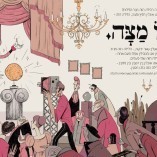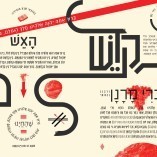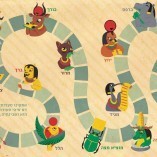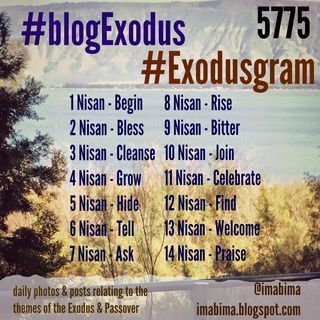Rachel Barenblat's Blog, page 132
March 29, 2015
#blogExodus 9: Bitter
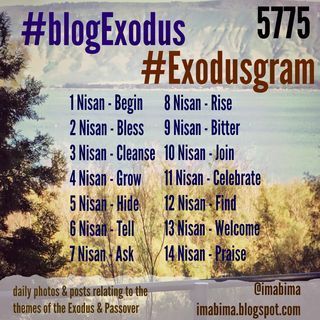 Bitter as in bitter herbs: the beet-stained horseradish of my childhood, magenta and pungent, dotting globes of gefilte fish.
Bitter as in bitter herbs: the beet-stained horseradish of my childhood, magenta and pungent, dotting globes of gefilte fish.
Bitter herbs as in horseradish root, and the way that nibbling its slices can make the sinuses and the back of the throat burn.
Bitter herbs, maror, which we eat on matzah -- combining the taste of slavery with the humble traveling-bread of our freedom.
Bitter like the hardships of slavery. Bitter enough that we cried out from the depths of our hearts, and those cries aroused divine mercy for us.
Bitter like fears of loss, like fears of rejection. Bitter like the fear that I could've done more, should've done more, and didn't, and now I can't. Bitter because sometimes it's too late to change the story we've already written.
Bitter because even in our moments of greatest joy, somewhere in the world there is sorrow. Sometimes in our moments of joy there's sorrow in our midst, too. It's a bitter pill to swallow, remembering that even at seder, some of us, somewhere, are grieving.
Bitterness is part of the journey. But thank God, it's not the whole journey. May there always be sweetness to balance the bitter. May the maror in our lives be startling but not painful. May it be bitter like arugula, like dark leafy greens, like bitter melon. Noticeable, but never the only flavor.
The taste of maror can wake us up. It's the springtime analogue to the sound of the shofar which awakens our souls as Rosh Hashanah approaches. Sleepers, awake, wake from your slumber! The time of our freedom is at hand. Take stock of who you are, prepare yourself for change and for rebirth.
When we leave the constriction of this Narrow Place, when we enter the wide-open spaciousness of freedom, we'll move to a diet of manna and gratitude. But we'll keep the hint of bitter in our story, in our seder, in our remembrance. Like the bitters in a cocktail, bringing life's sweetness into fuller form.
This post is part of #blogExodus, a daily carnival of posts / tweets / status updates relating to themes of Passover and Exodus, created by ImaBima. Find other posts via the #blogExodus hashtag.
March 28, 2015
#blogExodus 8: Rise
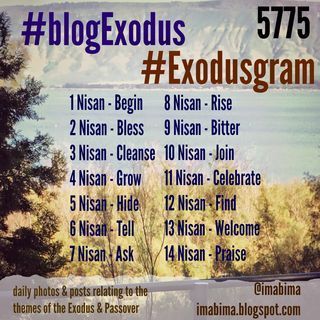 Years ago I attended an Easter morning service at my friend Peter's church in Williamstown. I went with our friend Bernard, visiting from Ghana. (I wrote an essay about it: A field trip into Easter.)
Years ago I attended an Easter morning service at my friend Peter's church in Williamstown. I went with our friend Bernard, visiting from Ghana. (I wrote an essay about it: A field trip into Easter.)
One of the moments which has stayed with me is Reverend Peter asking, at the end of his sermon, "Will you rise?" -- and the pregnant pause during which we all realized that it wasn't "just" a spiritual question but was also a literal one.
"Everything that rises must converge," wrote Pierre Teilhard de Chardin. He believed that all creation was rising toward the Omega Point, the highest possible level of consciousness toward which the universe continues to evolve.
I don't think the rising he's describing happens automatically; I think that there is spiritual work involved. But I like the idea that ultimately there is convergence. That in the end we all come together. As a Jewish Renewal chant has it, echad yachid u'm'uchad -- "one, singular, united" -- or, in singable English, "The One, every single one, each one joined and united in the One." We come from unity and we return to unity.
As Pesach approaches, of course, the kind of rising most of us are thinking about is a literal rising -- the uplift in fermenting bread dough caused by yeast. Some of us cleanse our homes of hametz, leaven; some of us cleanse our hearts of spiritual hametz, the puffery of ego. For a week we will eat only matzah, eschewing foods which are risen. And yet Pesach is a time of great spiritual ascent. Our bread may be flat, but our souls are invited to soar. Time for our spirits to rise.
This post is part of #blogExodus, a daily carnival of posts / tweets / status updates relating to themes of Passover and Exodus, created by ImaBima. Find other posts via the #blogExodus hashtag.
[image error]March 27, 2015
#blogExodus 7: Ask
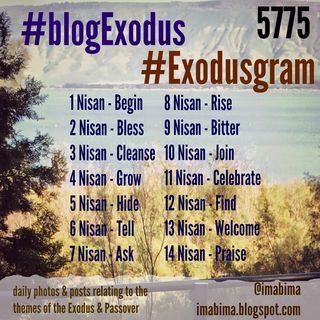 Every night before bed I sit with our son and we say our prayers (asking God to bless everyone we know and love, "and everybody else, amen" and the shema) and then we sing a handful of songs.
Every night before bed I sit with our son and we say our prayers (asking God to bless everyone we know and love, "and everybody else, amen" and the shema) and then we sing a handful of songs.
There's a lullaby we've been singing to him all his life which is still part of our bedtime routine (though just this week he's beginning to insist that he's outgrown it, which feels bittersweet.) Usually one of us also sings "I Love You, A Bushel And A Peck."
About a month ago, around Purim-time, I started adding the first question of the Four Questions to our bedtime routine. Within a couple of weeks, he was singing along. Now he sings the whole first question by himself proudly, and sings along with most of the words of the other questions too.
I love hearing him sing the Four Questions. My heart swells every time I hear it. One of my strongest memories of my own childhood seders is of singing the Four Questions proudly in front of my aunts and uncles and cousins. It was my job, and I loved that moment in the spotlight. That our son is now growing into that role brings me tremendous joy.
Asking the questions is central to the seder. Why is this night different from all other nights? Why are we doing these unusual things? Why are we putting pillows on all the chairs, why are you roasting an egg, why are we reading a storybook during dinnertime, why do you have your guitar at the dinner table, why are we hitting each other with scallions? According to one theory, all of the rigamarole of the seder evolved precisely in order to spur kids to ask the question "why."
Because when the kids ask, then we can answer. We do this because of what God did for us when God brought us forth from slavery to freedom, from constriction to expansiveness. We do this to remember that we are free and that with freedom comes responsibility. We do this because it connects us with the generations and with our community around the globe, through all space and time. We do this because it makes you want to ask, and when you ask, then we can tell you this story which we so love.
This post is part of #blogExodus, a daily carnival of posts / tweets / status updates relating to themes of Passover and Exodus, created by ImaBima. Find other posts via the #blogExodus hashtag.
Last year I wrote a poem in response to this prompt. It's here: Daily April poem for #blogExodus: Ask.
March 26, 2015
Beyond Walls faculty spotlight
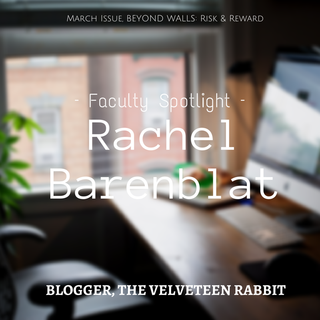 I'm honored to be the subject of the Faculty Spotlight in the latest issue of Beyond Walls, the online journal dedicated to the program of the same name in which I'm teaching this summer. Here's a taste:
I'm honored to be the subject of the Faculty Spotlight in the latest issue of Beyond Walls, the online journal dedicated to the program of the same name in which I'm teaching this summer. Here's a taste:
I think of Velveteen Rabbi as akin to an intimate coffee-table conversation, even though I know that my words are going out to thousands of readers. Through the blog I invite people in to my virtual home. Pull up a chair, pour yourself a cup, and listen to this beautiful Hasidic teaching I learned about the holiday cycle. Or here's a piece of Torah with which I'm struggling this week: how do you approach these verses? It's a back and forth, and I welcome conversation with my readers.
Read the whole thing here: Faculty Spotlight | Rabbi Rachel Barenblat. (I also really like the graphic they put together to accompany the piece, though am amused by the typo, which is a common one; most folks are more accustomed to typing the name of the Margery Williams book than typing the name of my blog...)
Beyond Walls: Spiritual Writing at Kenyon is a summer program at the Kenyon Institute designed to assist clergy in becoming more confident and expressive writers to both congregational and external audiences. Read about it and sign up now at their website.
#blogExodus 6: Tell
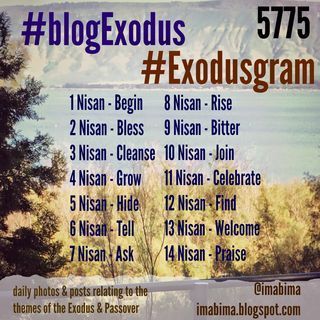 At the center of the seder experience is the step in the seder known as Maggid -- "telling the story." (The word maggid shares a root with haggadah; the Haggadah is the book which tells the tale.)
At the center of the seder experience is the step in the seder known as Maggid -- "telling the story." (The word maggid shares a root with haggadah; the Haggadah is the book which tells the tale.)
We are helped, in our storytelling, by the materials we have at hand -- both our printed haggadot, and the stirrings of our hearts. Not surprisingly, my family uses the Velveteen Rabbi's Haggadah for Pesach to guide us along the way. But although it's the haggadah I've assembled, it's not the only one I love.
I love all kinds of haggadot. I love the classical text, and I love the many variations thereupon, and I love that a haggadah can still recognizably be a haggadah even when things change. Hebrew or vernacular (or both), prose or poetry (or both), minimalist or maximalist -- I love them all.
Right now I am enamored of the latest addition to my haggadah collection: The Asufa Haggadah, 2015 edition. Here's how the publisher describes it:
It’s become a tradition: every year, a group of more than 40 Israeli artists comes together and creates a new haggadah. They follow only two rules:
Each artist creates only a single page
The artists must use the standard Haggadah textNow, for the first time, that haggadah is available in North America, exclusively through Print-O-Craft.
The haggadah is stunning. Every page is different and every page is beautiful. The art brings the story to life. I'm a wordsmith; words have long been my trade. But this haggadah is as much about the visual storytelling as it is about the text, and I find myself lingering on every page. This is transformative work: the art changes my experience of the existing, and familiar, Hebrew text.
I love that this is how we both celebrate, and continue to create, our peoplehood: by telling a story. Once upon a time we were slaves to a Pharaoh in Egypt, and the Holy One of Blessing brought us out from there with a mighty hand and an outstretched arm.
There are so many ways to tell this central tale.
This post is part of #blogExodus, a daily carnival of posts / tweets / status updates relating to themes of Passover and Exodus, created by ImaBima. Find other posts via the #blogExodus hashtag.
March 25, 2015
#blogExodus 5: Hide
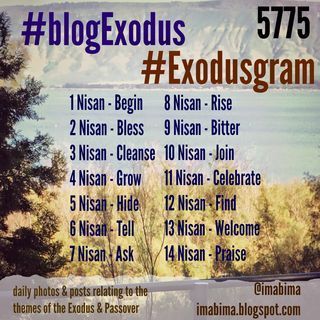 At Purim, God hides. The Name of God appears nowhere in the Megillah -- though divine presence is woven through the story for those with eyes to see.
At Purim, God hides. The Name of God appears nowhere in the Megillah -- though divine presence is woven through the story for those with eyes to see.
At Pesach, God is everywhere in the story. "And the Holy One of Blessing brought us out from there with a mighty hand and an outstretched arm..." There is nothing hidden about God during the Passover story.
In the shift between the two holidays I see a familiar oscillation. Sometimes God seems absent, or at the very least hidden. Hester panim, the mystics say -- "the Face is hidden."
Just as, at moon-dark, the moon's face is hidden from view though we know she still orbits our earth -- in that same way, sometimes God's face is hidden from view. Hidden from us.
Sometimes God is so present it seems there ought to be trumpets and fanfare. Beams of light stream through a break in the clouds -- a mighty waterfall thunders -- a baby is born and new life enters the world -- one comes face-to-face with another being, animal or human, and a spark of connection becomes manifest -- old bonds shatter and the heart becomes free...
And maybe sometimes we hide ourselves from God. We turn away and hide our faces. When we've done something we regret, something which brings us shame. When we can't bear the luminous, the numinous, because we feel too fragile. When we can't imagine that we could be forgiven. Though as an old Sufi story has it, even when we think we're hiding, there is One Who always sees us.
And even when God seems to be hiding, that One is still present in our lives. Even when God is as hidden as the moon, as hidden as the Afikoman we'll wrap in a napkin and conceal. We hide the Afikoman so that it can be found. Maybe God, too, hides in order to be found. Hide and seek. Come and find Me. Yearn for me, and I will be revealed.
This post is part of #blogExodus, a daily carnival of posts / tweets / status updates relating to themes of Passover and Exodus, created by ImaBima. Find other posts via the #blogExodus hashtag.
March 24, 2015
#blogExodus 4: Grow
These are hostia shoots, photographed outside our house one year in early May. I look forward to their return -- though I know it will be several weeks before I see any such thing. The snows fell high and thick this year. It's going to be a while before anything can safely poke above-ground and visibly grow.
But under the surface of the earth, new life is preparing itself to rise. There will be hostias again, and hydrangeas. There will be crocuses and tulips and daffodils. A whole verdant spring is waiting. Sometimes growth is almost imperceptible, but that doesn't mean it isn't happening all the same.
Pesach comes at this season of new growth. The karpas, the parsley we dip in salt water early in the order of the seder, represents the spring green of new life. And the Pesach story is also a story of our community's growth from a ragtag bunch of slaves to a people capable of striving toward covenant.
How have I grown since last year at this season? Am I wiser, kinder, more compassionate? Am I willing to poke my vulnerable shoots out of the safety of familiar earth, to reach out toward the air and the sun, to risk the dangers of letting myself grow?
This post is part of #blogExodus, a daily carnival of posts / tweets / status updates relating to themes of Passover and Exodus, created by ImaBima. Find other posts via the #blogExodus hashtag.
March 23, 2015
Euphoria, Curiosity, Exile & the Ongoing Journey of a Hasidic Rebel: A Q & A with Shulem Deen in Zeek magazine
I am thoroughly delighted that Zeek just published my Q and A with Shulem Deen, the man who used to blog as Hasidic Rebel -- now author of All Who Go Do Not Return, new this week from Greywolf Press.
You can find my interview at Zeek: Euphoria, Curiosity, Exile & the Ongoing Journey of a Hasidic Rebel: A Q & A with Shulem Deen. It's long, but I think it's worth reading; I hope you'll agree. I'm also archiving it here, so you can read it here, below. Deep thanks to Zeek for giving me the opportunity to connect with Shulem, and to Shulem for a terrific conversation -- hopefully the first of many over years to come.
When I began blogging as Velveteen Rabbi in 2003, I spent a lot of time building my blogroll — the list of links to other bloggers with whom I felt some kinship or whose work I felt was interesting and worth reading. One of the first blogs I started reading, back in those early days of the Jewish blogosphere, was Hasidic Rebel — written by a Hasid who sought an outlet for opinions and ideas that would have been considered heretical in his community. His blog, named for his persistent pseudonym, was also thoughtful, witty, and insightful — some of the best writing in the J-blogosphere.
In 2010 Hasidic Rebel came out and acknowledged his name. I remember feeling happy for him that he felt able to publish online under his “real name.” But I had little idea at the time what he’d gone through in order to get there — or what kind of struggles still lay ahead.
This week, Graywolf Press is releasing All Who Go Do Not Return by Shulem Deen, the man once known as Hasidic Rebel who went on to become the founder/editor of the website Unpious: Voices on the Hasidic Fringe.
All Who Go Do Not Return is an extraordinary memoir. The writing is beautiful. The journey it chronicles is poignant, relatable — and also unlike anything most readers will ever have experienced. As a young man, Shulem Deen chose to join the Skverers, one of the world’s most intense and insular Hasidic communities. He married, and became a father to five beloved children. And then his natural inclination to learn and to question drove a wedge between him and the Skverer world.
This isn’t the first time we’ve featured his words here in ZEEK — don’t miss his 2013 essay Why I Am Not Modern Orthodox. But it’s the first time we’ve interviewed him. I’m humbled by his bravery and his openness.
His voice is an important one in our generation.
— Rachel Barenblat
ZEEK: Many of the people reading this piece won’t know about your background (and may not know of New Square). So for their sakes: tell us, in brief, about where you come from?
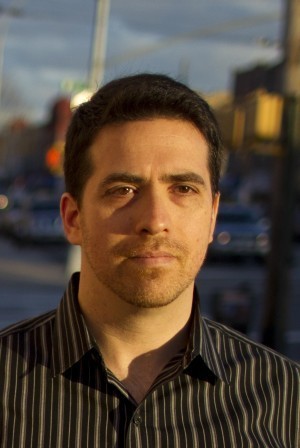 I was raised within New York’s broader, ultra-Hasidic (i.e. non-Chabad) community, which is composed of many sects, some stricter than others but all more or less of the same cloth: Yiddish-speaking, shtreimel-wearing, rebbe-centered, with strong emphasis on Hasidic custom and practice, and a near-fanatical insistence on remaining separate and apart from the outside world — geographically, intellectually, and culturally.
I was raised within New York’s broader, ultra-Hasidic (i.e. non-Chabad) community, which is composed of many sects, some stricter than others but all more or less of the same cloth: Yiddish-speaking, shtreimel-wearing, rebbe-centered, with strong emphasis on Hasidic custom and practice, and a near-fanatical insistence on remaining separate and apart from the outside world — geographically, intellectually, and culturally.
My childhood was mostly spent among the Satmars, in Borough Park, Brooklyn. As a young teenager, however, I grew close to the Skverers and found that it suited me more. I eventually went to study at the Skverer yeshiva in New Square, where I later married and lived for a dozen years with my wife and five children.
ZEEK: What was sweet, for a time, about life as part of the Skverer community?
The Skverers are more provincial than most other sects, due to the relative isolation of the New Square shtetl, so there is a degree of old-world simplicity that really appealed to me as a 13 year old. As a community, the Skverers are warm, hospitable, openhearted, and, on the whole, appear to be less preoccupied with materialism than some of the more “urbane” Hasidic groups. (Key words: “appear to be” — as appearances can be deceiving.) The shtetl is in fact a real shtetl (albeit American and suburban), and when I first encountered it back in the late ’80s, it had all the charms of a storybook setting.
There was also a palpable sense that this was an extremely pious community. By pious I mean less a concern with rules and strictures as much as possessing deep personal faith that radiates outward in a way that’s inspiring and uplifting rather than constraining.
The Skverer attachment to early Hasidic teachings also surprised me. As a child, among the Satmars, there was a sense that today’s Hasidim no longer maintain an authentic Hasidic tradition. (The late Satmar rebbe, R. Yoel Teitelbaum, famously wrote, “The teachings of the Baal Shem Tov have been forgotten”). But among the Skverers, such a notion is almost blasphemous. Whether they truly live by those Beshtian principles is maybe a different questions, but the Skverers certainly believe the old teachings to be relevant, and at least a good portion strive to live by them. To me, even as a 13-year-old boy, the notion that there are people who lived, both physically and spiritually, as if in a Beshtian-era, had a romantic, almost fairytale-like quality.
The Skverers also maintain an attachment to their rebbe that is somewhat unique among Hasidic groups today — in the degree of devotion, and the fierceness of it — especially among American Hasidim. Having come to them from the Satmars, this was striking; the Satmars too are rebbe-centered, but they take a comparatively relaxed attitude to it all. The Skverers, on the other hand, see their rebbe as truly supra-human, i.e. a literally different class of human being. This sounds cultish, perhaps. But to me, witnessing it as a child, it had an extremely powerful effect.
All of this is to say: The things I initially appreciated among the Skverers were things I encountered at an extremely impressionable age. And they were fairly superficial. I wouldn’t say there was no substance to any of it, or that it wasn’t meaningful in a deeper way, but the real attraction was toward the somewhat deceptive sheen covering it all. So these things were certainly “sweet,” but I hesitate to make too much of that sweetness.
There was a more real, and deeper, sweetness later on, in my late teens, early twenties, when I was more strongly attached to my studies of Hasidut and came to feel a real sense of (what I thought then was) the euphoria and ecstasy that early Hasidim must have experienced. It feels corny to speak of it now, as I do not actually believe in such things as spiritual phenomena. But I do know for certain that the experiences were real and powerful, and in a sense intoxicating — like in Abraham Maslow’s “peak experiences,” which I reference in the book. And that was quite sweet, indeed.
ZEEK: What changed, for you, as you began to question? And how did the change begin — was it because you were listening to the radio that your curiosity began to grow, or was it because your curiosity was growing that you began listening to the radio?
I think I was simply maturing, losing some of the youthful idealism and passion for the “purity of heart and mind” that I had once strove for, and I began to feel somewhat restless. And the outside world beckoned. It’s hard to describe. I think I had lived for a long time just satisfying an emotional need — the studying for a higher purpose and the Hasidic fellowship and the attachment to the rebbe served all of that well. But intellectually, I was unsatisfied.
I had a very base desire to know and understand what the real world was about, what other lives were like, what were simply the facts about our society and other societies, how we live as human beings in this world, and what made us all different and in what ways we were really all the same. Like many others who recognize we live in a complex world, I’ve often felt inclined to consider the counterintuitive, to seek out that which seems to break the pattern, to challenge my own assumptions. And I think what I was doing then was not simply attempting to satisfy a curiosity but attempting to resolve something: to reach an understanding of the world on my own terms, rather than accept what was given to me by some authority.
All of this is from hindsight, of course. At the time, all I felt was a drive to explore. Nothing more. And the drive was simply unstoppable. I’d been a curious child, and had done a lot of reading. But from around the age of 14 until my early 20s, it was like a decade of darkness; I had no access to anything outside of what was available in the shul or the yeshiva or the New Square seforim store. There are no secular bookstores in New Square, and until I got my car, at 24, I had no way to get around really. Additionally, during the first years of my marriage, I generally refused to read any English-language material, as it was strongly frowned upon. Not that I’d have had much to read, but occasionally a local newspaper would arrive in the mail for free, or something of that sort, and I would toss it out, like it was profane. And there was something deliberate in not allowing my own curiosity to get the better of me.
And then came a point when I simply could no longer suppress it.
I think there’s also something about married life, and the realities of family obligations and raising children that puts you in a more worldly frame of mind. It’s easy to be a monk in a monastery, or to embrace asceticism while living a solitary life out in the wilderness, but it’s a bigger challenge to do so while also having to pay bills and provide food and clothes for a family. For me, the yeshiva and kollel environment were conducive to a high level of spiritual focus — no wives or children to distract you from study and prayer and all that. But while some are able to use that training to sustain that focus even later, I suppose I just didn’t have it in me. And so as my spiritual focus receded, so did the discipline to keep the outside world at bay.
ZEEK: Tell us why you started blogging as Hasidic Rebel.
The blog was really kind of a fluke.
I had no intention of blogging in a rebellious way. I wouldn’t have dared! The idea that one can have a dual identity — one in real life and another online — was totally strange. I am a fairly open person, in the sense that I share about myself freely. But having had to repress an essential part of myself in real life, I couldn’t imagine a space in which I could be open about it. I could only imagine a dual identity in the sense that one is internal, my inner thoughts and feelings, and one is external, that which I present to the world and give voice to. (I did have a few online forums where I shared my thoughts with others, but those were so limited, and even there, I mostly lurked.)
So it was almost an accident that I wrote a few posts criticizing the Hasidic world, almost as an outburst of sorts. They were fairly tame, really. But I’d stepped past a certain level of inhibition. And only when I realized I had done so did I take my name off my blog and create a pseudonym. Even then, it was hard to believe that here was a place of true freedom. Except, once I started, it was like a pressure valve had been opened, and I simply had to let parts of myself flow.
I was not very open about my doubts on more foundational issues, matters of dogma, etc. — in part because my own doubts and beliefs or non-beliefs were still shifting and amorphous. But it didn’t feel necessary to share those things either. To the degree that the blog was to achieve anything, I was able to achieve it just by creating a connection to the world beyond my own.
Ultimately, the blog proved immensely therapeutic. After six months, I felt like a changed person. Until then, for several years, I had begun to feel almost imprisoned, with this rising anger toward the people around me and the society I was living in, but feeling resigned to living like this for the rest of my life, which felt really depressing. But those first six months of blogging gave me the ability to think more clearly about my choices, and about why I was where I was.
The single most important thing I learned from that period was that my living in the community was, in fact, a choice — something I’d never considered before. I realized that doing nothing is also a choice: I was physically able to pick up and leave; I didn’t do so not because I wasn’t able to, but because I didn’t want to, because it was not a step I was prepared to take at that point. True, if I left I would’ve lost a lot, but that’s what it means to make a choice. Staying was the price I paid to avoid whatever I would lose by leaving. And there was something powerfully liberating in that realization.
ZEEK: When the beit din sent you away from New Square, was that exile?
Being sent away was difficult. Not because I didn’t want to leave New Square, but I wanted to leave on my own terms. Being expelled deepened my feelings of alienation from the Hasidic world before I was ready to break away. Also, when the beit din expelled me, it felt like they expelled me from the entirety of Hasidic society, not just from New Square. When you’re expelled from a Hasidic community for “heresy,” it is difficult to become a full-fledged member of a different Hasidic community — the Hasidic world is fairly small, and such news travels easily. So in that sense, yes, it felt like exile. Even though New Square wasn’t for me, there wasn’t any other place for me either. And when we moved to Monsey, we didn’t really join a community, we simply lived in a neighborhood with other Hasidim but were completely unattached to a particular group.
I feel it’s important to note, though, that the sense of exile was deepened by the kind of marriage I had. My wife was still very devout in every way, and insisted not only on her own private religiosity but that as a family we continue the full array of practices and lifestyle choices with which we’d lived earlier. For whatever reasons that she is the person she is — and I do not judge her or blame her for this at all — she simply could not live any other way. But this meant we couldn’t take on a more modern observant lifestyle, which meant that a more modern community wasn’t an option for us. So effectively, being expelled from New Square meant being disconnected from almost any kind of community.
And so to continue living a Hasidic lifestyle while feeling rejected from it was indeed painful and very disorienting. As much as I felt freer to be who I was, it felt like I was living in a state of rejection, and there’s a lot of shame associated with that. And my ultimate decision to leave was, on some level, an attempt to shake off the shame of that rejection. Of course, there was the strain it put on my marriage as well, but the feeling of alienation and rejection was really overwhelming.
ZEEK: What has been most surprising for you about getting to know the secular/non-Hasidic world?
Most surprising is how many people in the secular world, too, seem alienated from their surroundings, with a real sense of aloneness (as distinct from “loneliness”). It wasn’t a surprise that people live more individual lives when they don’t have tightknit communities. But the degree to which people yearn for community but struggle to find it has been surprising. It’s also somewhat comforting. Because for a while I thought my own yearning for community as a secular person was just a yearning for something I once had and lost. But it seems I am far from alone in this.
Perhaps more surprising are the things that have been disillusioning. I think the secular world sits really high up on its horse when it comes to criticizing religious communities, but the secular world isn’t doing so spectacularly in so many crucial areas — the most obvious issues of course are income inequality, lack of opportunities for the historically disadvantaged, rates of incarceration, the purposelessness in the lives of many young adults, the staggering rates of depression and anxiety, the intergenerational disconnects (i.e. little appreciation for the lives and experiences of parents/grandparents). Etc. etc. And so their critiques of the ultra-Orthodox often fall flat to me. The Hasidic community is certainly flawed, but I left not because its flaws are so great but because there was no longer a place for me. But others do find their place there, and are quite happy and fulfilled within it.
None of this is to say that I think the secular world a bad place. Only that when I see secular people looking to insular religious communities as if those are uniquely dysfunctional, it suggests to me a lack of perspective, and perhaps an inability to appreciate the varieties of human experiences and values. And that’s been both surprising and troubling.
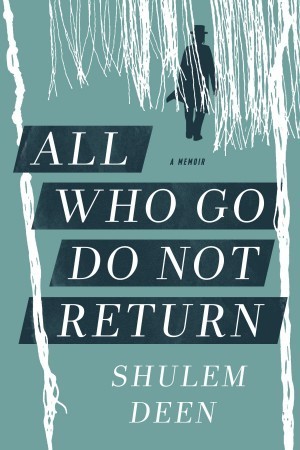 ZEEK: Reading your memoir, I found myself frequently making marginal marks to remind myself of passages I wanted to read again. In one such passage, you wrote about your father’s unorthodox view that other religious traditions provide, for their adherents, a legitimate path to God. You couldn’t accept that truth then, surrounded by voices that argued otherwise. How does your father’s view sound to you now: right, wrong, naive?
ZEEK: Reading your memoir, I found myself frequently making marginal marks to remind myself of passages I wanted to read again. In one such passage, you wrote about your father’s unorthodox view that other religious traditions provide, for their adherents, a legitimate path to God. You couldn’t accept that truth then, surrounded by voices that argued otherwise. How does your father’s view sound to you now: right, wrong, naive?
Well, my father was a religious man, and I am not one. Not anymore. So from my perspective now, it’s hard to relate to such a view from a personal position. But I certainly don’t think he was naive. I may not be a religious person, but I do understand (and, to some degree, respect) the religious impulse, and I think that impulse is in some sense universal — not that every human has it, but that the impulse to be a devout Jew is not fundamentally different from the impulse to be a devout Christian or Muslim. I will add also that, while I can respect religious belief and practice as something that fulfills a human need, I can only respect it as that — as something that offers its practitioners something they need/want for themselves, rather than some dogmatic insistence on this mode of practice being superior, or exclusive, or mandatory, etc.
I can respect faith, but I have no tolerance for dogma.
ZEEK: If you could send a message back in time to the person you used to be, what would you want to tell him? (Would he be able to hear you?)
This is a tough question. For a long time I mourned the loss of my faith, and wished I’d never encountered all those things that led to losing it. So I would’ve warned myself not to go down that road.
But now I feel more the consequence of having lived a life led not by my own choices but by what others chose for me. I followed all the guidance I was given: what to believe, what kind of education to pursue, whom to marry, how many children to have, how to earn a living, etc. By the time it no longer worked for me, there was too much to lose. So I’d have to say, I’d tell myself to follow my own path from an earlier point. And yet, I’m not sure this is really a meaningful message. Because at the time, submitting to authority — and being subsumed by the collective rather than living as an individual — felt like that was my path. So I’m really not sure. It’s a tough one.
ZEEK: You wrote that Hasidism arose as a mystical movement, seeking to plumb the depths of spirit rather than the arcana of law — and yet it’s evolved into the most insular and unbending variety of Judaism. (Or perhaps it’s fairer to say that it hasn’t evolved — to some extent it’s stayed in the 1700s while the rest of Judaism has changed around it.) Is it inevitable that mystical movements calcify and need to be abandoned or changed?
I think we have to differentiate between Hasidism (the movement), and Hasidim (the people and their society). I’m not sure that Hasidism qua Hasidism — “Hasidut” — is different now from what it was in its origins. I think the people named for it have shifted direction while keeping the name and some of the outward expressions. (And the term “Hasidic” I see more as referring to the society rather than the movement.) Hasidism itself consists of the teachings and a certain ethos, and those can be adopted by anyone, even in the fully modern world. But Hasidim the people were formed not by Hasidism alone but also by the upheavals that followed the Age of Reason and the Jewish Enlightenment, which then created that second reactionary movement (or perhaps a second “wave”) among Hasidim that led to that calcification we now see. This is largely the influence of the Chatam Sofer — who was not a Hasid — who was reacting to the Reform movement out of Germany, but it isn’t from Hasidism itself. The essential teachings of Hasidism do not require anything like the insularity of the Hasidic world today.
I would’ve loved to see a true Hasidic movement that is also modern. Maybe Reb Zalman was on to something, although I wonder to what degree his followers engage with original Hasidic texts.
ZEEK: In my experience, those of us who seek rabbinic ordination do immerse ourselves in original Hasidic texts; Hasidut is a major part of the ALEPH rabbinic program’s curriculum. But those who are part of Jewish Renewal but aren’t clergy probably encounter those texts in excerpts and in translation, by and large.
Shlomo Carlebach (for all his personal flaws) also had a spark of it — maybe not with Reb Zalman’s depth, but he could certainly move the masses. These are authentic expressions of Hasidism that can fully exist with modernity.
Some Hasidic groups are better than others in this respect. Satmar is indeed as you describe, “insular and unbending,” and with little of that authentic Hasidic ethos to soften it. Chabad, while imperfect (and for all my distaste for some of what they do), is worlds better in this regard. Skver might fall closer to Satmar, but I see it as having a stronger essence of real Hasidut, which Satmar lacks. So it really depends on the group. But yes, I think the essence of Hasidism as a mystical movement can exist in the modern world. I have no doubt about it.
ZEEK: For most American Jews, I think, the kind of Hasidut you describe has an incredibly high bar to entry — the Hebrew, the Aramaic, the Rashi script, the dense thicket of intertextual references that characterize the received tradition. I think most of our readers know what it’s like to be fluent in American pop culture and to struggle with the Shulchan Aruch. What was it like for you to make that journey in the opposite direction?
It was incredibly difficult! And that’s such an apt comparison, the learning curve both ways is really steep. Although I’d have to say that as difficult as it was to catch up on movies and pop music and to learn proper restaurant etiquette or to gain some kind of fashion sense (sadly, still haven’t managed), or to figure out the dating scene, or to get a handle on the basics of art and literature and the world of science and to generally learn the language of modernity, I have to say: it probably doesn’t compare to that dense thicket of intertextual references of the Orthodox world. So I guess, from that perspective, an ex-Hasid has it easy.
But taken on its own, the transition really is a tough one. I was lucky that my command of English is fairly good, mostly because I’d been such a voracious reader as a kid, and read anything I could get my hands on, and so at least I didn’t have that hurdle. But even so, it takes a long time to really feel like the secular world is a world you belong in. Eventually, you realize that everyone’s winging it, and that everyone struggles to find their place in the world, to figure out life for themselves, to surround themselves with people that will help them grow and be at ease with themselves, but it takes a while to learn that. I can thankfully say that now, seven years out, at the age of 40, I feel fairly comfortable at where I’ve arrived, and fairly secure with myself as a secular person so that most of the insecurities of being a secular “newbie” have subsided. But it wasn’t an easy road.
ZEEK: Are there texts from your former life that still hold meaning for you now, or are they all tainted with painful associations?
They’re not so much tainted with painful associations, as much as they’ve lost their ability to impart meaning. But some of it still stimulates me. I don’t study Talmud with any kind of regularity, but I will occasionally look something up, and find myself engrossed a bit longer than I expected. Similarly with certain volumes of responsa — medieval or modern. And scripture is still endlessly engaging — it is my first love, you might say. Studying Tanach without the commentaries, to study the text for its plain meaning, was one of my first acts of curiosity that felt somewhat subversive — this was back when I was still fully religious. Scriptural texts, in their plain and simple meanings, are not emphasized within Hasidic environments, and it requires actual work to forget Rashi or Ramban’s commentary, or the various Midrashim, just to get at the plain essence of the thing. And so studying Tanach to this day (except for Leviticus, perhaps) remains an intellectual treat.
ZEEK: Describing your first time in a secular library as a grown man, you wrote about the sense of wandering in a maze of knowledge with the goal not of finding a way out but of picking up as much as you could along the way. That resonates with me. It’s not about the destination, but about the journey; not about the answers, but about the questions. Growing up, I was taught to see that stance — it’s all about the questions, and the process of questioning, not about the answers per se — as central to Judaism. But it seems clear that questioning was forbidden in the community you came from. I’m wondering now: is that a fundamental disconnect between liberal Judaism and ultraorthodoxy / Hasidut? Is it even fair to say that we are all part of klal Yisrael, part of one Jewish community, when we differ in such ways?
I often wonder about this, to what degree we are all one community, or even one people. I think our oneness lies in a shared history, even if our shared present isn’t so clear. And nothing epitomizes that shared history more than the texts: we all study the same Talmud, the same Rashi, the same Maimonides, the same Yehuda Halevi. And truthfully, that’s what always created klal yisrael: the Jew in Poland, the Jew in Spain, the Jew in Yemen, or the Jew in Baghdad often had different practices, and they certainly made up different cultures, and from a genetic perspective might not really be the same “people,” the way we often understand peoplehood. But they had the texts in common.
I often think of this in relation to Karaite communities, or even the Samaritans, and other older offshoots from the rabbinic mainstream. Arguably, the differences between rabbinic Judaism and other forms is not substantially different from the differences today between the Orthodox and more liberal forms of Judaism. But most Jews I know don’t consider Karaite communities “Jewish” in an unambiguous way (and certainly not the Samaritans), whereas even the most fanatically ultra-Orthodox will consider the most ardently Reform Jews to be halachically Jewish and part of the Jewish people — as long as they’re born of Jewish mothers, etc.
At the same time, I’m not optimistic about such unity being sustainable. Only time will tell, but I do think we’re headed for an even deeper split between halachic and non-halachic communities. Perhaps we’ll end up with some form of denominational Judaism that is closer to what we see in the Christian world, i.e. religious communities that share a spiritual heritage but are not considered to be the same faith per se. Especially once liberal Judaism moves into less of a peoplehood-oriented religion, and more faith-based, with people being able to both opt in and opt out with ease. And I’m not entirely sure this is such a bad thing. (Why should matrilineal or patrilineal or any-kind-of-lineal descent decide a person’s faith rather than a person’s own personal conviction?) We’re not there yet, but maybe this is where we’re headed, especially where the trend is to encourage conversion of non-Jewish spouses, or those who generally believe the long-term viability of Judaism lies in its power to attract outsiders as much as keeping in insiders. Conversion, even in mass numbers, isn’t a new thing, of course. But if conversion means something entirely different between different streams, then a large number of conversions has the power to create essentially multiple Judaisms. And maybe that’s not a bad thing.
ZEEK: Another moment in your memoir that was incredibly poignant for me was reading about your yearning to borrow “the book that will make the questions go away” — and knowing there’s no such thing. In a way it’s a loss of innocence. In opening your mind to the riches of the broader world, you tasted the fruit of the tree of knowledge. And once that change had taken place, it couldn’t be undone. I was moved by the passage about wanting to re-experience the ecstasy and the feeling of the sublime that had come from singing Yedid Nefesh with your community, and recognizing that that feeling was gone. What you had, and left behind, is something that a lot of liberal American Jews romanticize and imagine that we yearn for — a committed, engaged community where every moment has the capacity to be sanctified by the ancient practices of our tradition. But your memoir makes clear that there’s a shadow side to that kind of insular life, and that deviating from that community’s norms comes with an incredible price.
Indeed, I do think the insular religious world is romanticized by some. And I might even say that “romanticized” is to give it a negative tinge when maybe there is justified admiration for what Hasidic communities are able to maintain, at least to some degree. But yes, there’s a shadow side. But the question is, as you asked: is that shadow side inevitable? Can committed, engaged communities with that kind of insular and focused (as you say “every moment … sanctified”) stance exist today without the problems we see? I think it’s possible, but I just don’t know if it can be artificially created, with long-term viability. And present Hasidic communities do not look to be reforming themselves any time soon.
ZEEK: Knowing what you know now, would you do anything differently?
I get asked this a lot: Would I have made the choice to leave? Honestly: If I had known that I’d be separated from my children, I would not have left. It’s as simple as that. It was a tremendous loss that was almost too difficult to bear, and I simply wouldn’t have contemplated it. But that separation wasn’t inevitable either. If I understood the family court system better, and had more and better resources, and protected myself more, I could’ve done a lot to avoid the outcome I got. The truth was, I simply wasn’t prepared.
Would I do it again if I were better prepared? I hope I’d have had the courage. Because I don’t believe in fear-based lives, and confining oneself to an unhappy and unfulfilled existence because of the threat of losing those you love most is a terrible prison to live in. No one should be placed in that situation — although sadly, too many are.
ZEEK: Thank you for your honesty and your willingness to tell your tale.
#blogExodus 3: Cleanse
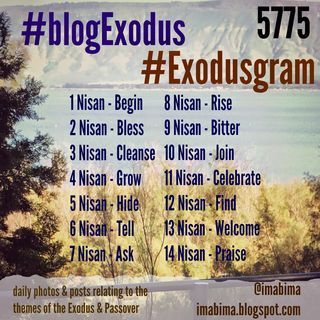 A few weeks ago Ethan misplaced his wedding ring. We realized on a Monday morning, and searched all week with increasing urgency.
A few weeks ago Ethan misplaced his wedding ring. We realized on a Monday morning, and searched all week with increasing urgency.
We hunted everywhere in the kitchen, even moving the stove to make sure it hadn't fallen behind. We opened up the baseboard heater and shone a flashlight inside.
Eventually we picked up all of the dining room furniture, put it atop the table, and scoured every corner. We were just about to give up...
...when Ethan found the ring -- in our coin jar. It had apparently slipped off his finger on a cold day as he was divesting himself of a pocket full of change.
We felt pretty sheepish when the ring was found. It had been hiding in plain sight the whole time. But we agreed that it was surprisingly nice to have such a clean dining room! Now that our child is years beyond the crawling stage, we don't spend a lot of time paying quite that much attention to the floor.
It felt like a prelude to Pesach, since one of the traditional ways of getting ready for the holiday is engaging in massive spring cleaning. The traditional reason, of course, is to rid one's house of even the tiniest crumb of hametz, leaven, before the holiday begins and we spend a week eschewing bread.
But I find that there's a spiritual component to it entirely separate from the intention of getting rid of leaven -- whether literal crumbs between the sofa cushions, or the metaphorical puffery of ego. Cleaning house, getting rid of things we don't need, always leaves me feeling lighter.
Nigel Savage is right -- getting rid of the "leaven" of old things -- piles of accumulated preschool art, sweaters which are no longer flattering, toys our son has long outgrown -- actually leaves my heart and soul lighter. It feels like throwing ballast off of a hot air balloon. The lighter I get, the more I can soar.
This post is part of #blogExodus, a daily carnival of posts / tweets / status updates relating to themes of Passover and Exodus, created by ImaBima. Find other posts via the #blogExodus hashtag.
March 22, 2015
#blogExodus 2: Bless
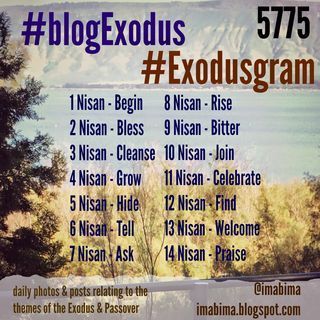 The seder unfolds over the course of fifteen steps. The Hebrew word סדר / seder means "order," and this is a ritual with a distinct order. In our house, we sing the fifteen steps in the order of the seder every time we come to a new step, a new stop, a new pause along the journey.
The seder unfolds over the course of fifteen steps. The Hebrew word סדר / seder means "order," and this is a ritual with a distinct order. In our house, we sing the fifteen steps in the order of the seder every time we come to a new step, a new stop, a new pause along the journey.
The first step is kadesh, which means "make holy" or "sanctify." We sanctify the sacred space of the seder meal by lighting candles and blessing juice or wine -- just as we do every Shabbat. (This year the first seder falls on a Friday night, so we'll bless candles for Shabbat and yom tov / holiday, and bless matzah a bit later in the meal.)
Creating sacred space is something we do together with God. The evening of the seder may have some intrinsic holiness, because for so many centuries we have observed the full moon of Nisan as the night when we commemorate the Exodus from Egypt, but most of its holiness (I think) arises in our partnership with God. We work with God to make it holy, using the tools of candles and wine and haggadah, scents and stories and song.
When we speak our ancient words of blessing, we usually begin ברוך אתה / baruch atah, "Blessed are You..." (Or, in Rabbi Marcia Prager's beautiful translation, "A fountain of blessings are You...") We assert that God is blessed. This may seem a chutzpahdik assertion, but we bless God. The power of that blessing lies in our hearts. And as we reach out to God and offer our blessing, God reaches back to us with shefa, divine abundance, streaming into creation. We bless God, and in return God blesses us.
Several years ago at the old Elat Chayyim I took a week-long workshop in the art of offering spontaneous blessings. I remember finding it strange at first. Turning to someone and saying, "May I offer you a blessing?" and then, at their nod, continuing with words customized to their situation -- that was difficult for me. (I think it became smoother, or at least more familiar, during my nine months of Clinical Pastoral Education. My Christian colleagues taught me a lot that year.)
Today I think of offering a spontaneous blessing in much the same way that I think about using the classical blessing formula (or its gender-switched or gender-neutral variations, which I also employ.) Making a blessing, whether traditional or ad hoc, is an act of reaching with my heart toward God and imploring God to open a channel so that shefa can flow through my words. As the moon waxes toward Pesach, what blessings do you most need to receive? What blessings are you most able to give?
This post is part of #blogExodus, a daily carnival of posts / tweets / status updates relating to themes of Passover and Exodus, created by ImaBima. Find other posts via the #blogExodus hashtag.
Rachel Barenblat's Blog
- Rachel Barenblat's profile
- 6 followers


